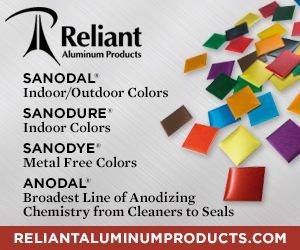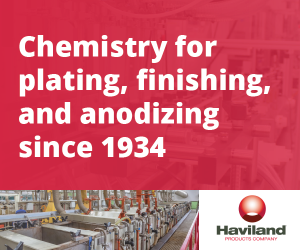POLLUTION CONTROL
Narrow by Pollution Control Product Category
- Absorbents for Chemical Spills
- Acid Salts
- Acids
- Air-Sampling Equipment (In-Plant Environment)
- Aluminum Etchants & Deoxidizers
- Anti-Static Solutions, Static Eliminators
- Associations, Tradeshows & Professional Groups
- Blowers, Air (for Push-Pull Ventilation)
- Centrifuges
- Chemical Transporting Equipment
- Chromate Conversion Coatings
- Chrome-Free Final Rinses (for Paint Pretreatment)
- Chromium-Free Conversion Coatings for Aluminum
- Cleaning Chemicals, Aqueous
- Consultants, Independent, Air Pollution Control
- Consultants, Independent, Water Pollution Control
- Controls, Liquid Level
- Controls, Spray Booth Exhaust
- Courses in Water Pollution Control
- Descaling Chemicals
- Distillation Equipment
- Dragout Solution Evaporators
- Drum Liners, Rubber, Plastic
- Drum Pumps
- Drum Warmers
- Drum-Handling Equipment, Accessories
- Dust Collectors, Dust-Control Systems
- Equipment Engineering & Installation Services
- Exhaust Systems
- Fans, Exhaust
- Filter Media for Dust Collectors
- Filter Media for Liquids: Bags, Cartridges & Rolls
- Filter Presses
- Filters, Breathing Air
- Filters, Compressed Air
- Filtration Equipment, Solution
- Flow Meters, Liquid
- Foam-Control Chemical Additives
- Foam-Control Chemical Additives
- Hazardous Waste Release Filing Service, Other Environmental Compliance Reporting Service
- Heat Exchangers
- Hoists, Traveling: Manually Controlled
- Oil Recovery & Recycling
- Painting Equipment, Ultrafiltration
- Phosphate Coating Chemicals
- Pipe & Fittings, Chemical Resistant
- Pipe-Line Strainers
- Pollution Control Chemicals, Chromium Reduction
- Pollution Control Chemicals, Cyanide Oxidation
- Pollution Control Chemicals, Heavy-Metal Removal
- Pollution Control Chemicals, Sulfide Precipitation
- Pollution Control Equipment
- Pollution Control Equipment, Activated Carbon Absorption
- Pollution Control Equipment, Catalytic Oxidation
- Pollution Control Equipment, Chemical Destruction
- Pollution Control Equipment, Electrodialysis
- Pollution Control Equipment, Electrolytic Destruction
- Pollution Control Equipment, Electrolytic Recovery
- Pollution Control Equipment, Evaporative Recovery
- Pollution Control Equipment, Fume Scrubbers
- Pollution Control Equipment, Incineration
- Pollution Control Equipment, Ion Exchange
- Pollution Control Equipment, Membrane Filtration
- Pollution Control Equipment, Ozonation
- Pollution Control Equipment, Reverse-Osmosis
- Pollution Control Equipment, Sludge Concentration/Conversion
- Pollution Control Systems Engineering, Air
- Pollution Control Systems Engineering, Water
- Regenerative Heat-Recovery Equipment
- Rinse Aids
- Rust Removers
- Rust-Preventive Chemicals & Oils
- Sludge Bags
- Sludge Dryers/Reducers
- Smut Removers, Aluminum
- Solvents, Degreasing
- Solvents, Mask Washing
- Steam Cleaning Compounds
- Surface-Active Agents
- Tack Cloth, Dust Removal Cloths & Mitts
- Tank Covers
- Tarnish-Preventive Treatments
- Test Kits, Water Analysis
- Testing Laboratories, Independent, Hazardous Wastes, Pollution Control
- Testing Laboratories, Independent, Water Pollution Control
- Ultrafiltration Equipment
- Used Equipment
- Valves
- Waste-Disposal Service
- Waste-Recycling Services
- Water-Softening Equipment
FAQ: Pollution Control
What greener (environmentally safe) paints do you recommend?
Greener (environmentally safe) paints available today come in the form of waterborne, high solids and some two-component materials. Use of these coatings will reduce emissions of volatile organic compounds (VOCs). Ask your paint supplier for specific product recommendations.
(Source: Greener Paints)
What makes waste hazardous?
According to the EPA, hazardous waste is defined as “a waste with properties that make it dangerous or potentially harmful to human health or the environment.”
Gold and silver cyanide solutions, as well as platinum group acid solutions are considered hazardous by default. Other materials, such as precious-metal-bearing filters, sludges or resins, should be evaluated using a range of criteria. Ultimately, the determination is subjective, but suppliers should seriously consider the risks associated with declaring their waste non-hazardous.
To determine if precious-metal-bearing electroplating waste is hazardous, the following characteristics, as defined by the EPA, should be considered:
- Ignitability. Ignitable materials can create fires or spontaneously combust, or have a flash point of less than 60°C.
- Corrosivity. Corrosive materials refer to acids or bases with a pH level of less than or equal to 2, or greater than or equal to 12.5 that have the ability to corrode a metal container.
- Reactivity. Reactive materials create explosions, toxic fumes, gases or vapors when heated, compressed or mixed with water.
- Toxicity. Toxic materials are harmful or fatal if swallowed or put in contact with skin, and can pollute groundwater if disposed of on land.
(Source: Is Your Electroplating Waste Hazardous?)
How do I dispose of plating wastewater?
Conventionally, precipitation has been the method most often used to remove heavy metals. Of the few precipitation methods, hydroxide and sulfide are the two main methods currently used, and hydroxide precipitation is by far the most widely used method. However, this method does not ensure total compliance for the various metals present in the waste stream, since all metal hydroxides do not completely precipitate at a single pH.
Often, post treatment polishing with scavengers such as dithiocarbamate or sulfide, both of which are noxious and toxic, is required in order to meet discharge standards. In practice, hydroxide precipitation is generally carried out at the best compromised pH for metals in the waste stream, normally between 8.5 - 9.5. Therefore, achievable concentrations may not meet discharge requirements. Additionally, the presence of chelating or complexing agents, oil and grease, synergistic reactions and high concentrations of dissolved solids can result in diminished efficiency of hydroxide precipitation.
(Source: Treating Plating Wastewater)
Is there a better pipe grade other than CPVC or PVC for caustic solutions?
Yes, there are better types of piping, but they are extremely expensive. Upon reviewing several corrosion resistance charts, we observed that all rated CPVC very high for both 25% and 50% caustic while there are some inconsistencies regarding PVC; while most rate PVC fairly high for caustic, one did not rate PVC well. To be safe, you may want to install CPVC piping.
(Source: Piping of Caustic)
How should companies respond to the government’s increased emphasis on compliance?
Maintaining an effective and current compliance program can significantly limit the impact of investigations. Be sure you have a risk assessment tailored to your company’s business, policies and procedures designed to address the company’s risk profile and a management strategy to help the company implement a meaningful compliance program.
One of the key features of an effective compliance program is periodic reassessment of the company’s risk profile and program. It is helpful to have an independent and objective view of a company’s risks and advice on how to limit those risks. This can be accomplished by hiring a consulting company or a law firm that has expertise in this area. The consultant/law firm often conducts such reviews on a fixed-fee basis to control costs. Compliance counseling includes:
- A risk assessment that targets the areas of greatest risk for a company's business, whether that means geographical areas that have historical challenges, particular lines of business, accounting practices and business relationships that may create regulatory risk;
- An evaluation of upper and middle management’s role in administering and supporting business ethics and compliance—evaluating the “tone from the top” regarding attitudes and resources dedicated to compliance;
- A review of the company’s policies and practices, such as written policies, procedures and training materials; reporting avenues for compliance challenges such as anonymous hotlines or published whistleblower policies; internal handling of compliance challenges, including stated disciplinary consequences for compliance program violations; how the company addresses relationships with business partners, affiliates and subsidiaries who may be beyond the company’s full control regarding compliance; contacts with competitors that can lead to antitrust compliance issues; and recommendations for improvements to the program.
Your compliance program is a living document. Treat it as such. Be sure to give it regular checkups to ensure a healthy and safe company.
When our mass finishing equipment is started after being shut down a week or more, an extreme stench emanates from the entire system. We are almost driven from the plant by the foul odors; sometimes a swarm of flies even rises up from the media! We now spray insecticide over the equipment before starting it, but the stench remains almost unbearable. How can we control this problem?
All good industrial compounds — that includes cutting and grinding fluids, washing fluids, hydraulic fluids, and so on — contain some chemistry designed to control the growth of mold, fungus, and bacteria. The quantity of such agents in a compound is determined by various considerations: operators’ safety, environment, tank life expectations and cost. The current problem is that tank life requirements have far exceeded the design parameters.
Your compound supplier should be able to guide you in choosing a chemical treatment that can be applied before a planned shutdown. This can be quite effective, depending on the circumstances.
(Source: Stench!)
Get Listed!
Thousands of people visit this Supplier Guide every day to source equipment and materials. Get in front of them with a free company profile.






